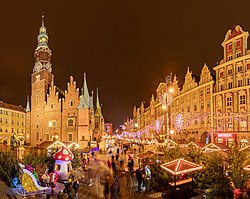User:Luziyca/Sandbox: Difference between revisions
No edit summary |
No edit summary |
||
| Line 81: | Line 81: | ||
===Great War=== | ===Great War=== | ||
===Independence=== | ===Independence=== | ||
With the independence of the [[West Miersa|Miersan Federation]] on 3 October, 1936, Krada became the {{wp|provisional capital}} of the newly-founded country, as although the [[West Żobrodź|western neighbourhoods]] of the city of [[Żobrodź]] was to become the capital of West Miersa, as Krada had been the administrative centre of the [[Narozalica|Narozalic]] [[Miersan Governate]], many of the government buildings were in Krada. | |||
During this period, while most national government buildings were moved to [[West Żobrodź]] from Krada, the city of Krada became (TBC). | |||
===Modern era=== | ===Modern era=== | ||
Revision as of 01:00, 15 August 2020
Krada | |
|---|---|
City | |
 | |
| Motto: TBD | |
| Country | |
| Voivodeship | Święciżar |
| Founded | 6 December, 1103 (traditional) |
| Government | |
| • Mayor | TBD |
| Population (2017) | |
| • City | 891,411 |
| • Rank | 1st in West Miersa |
| • Urban | 891,411 |
| • Metro | 1,129,050 |
| Time zone | TBD |
| • Summer (DST) | not observed |
Krada is the largest city of the Miersan Federation, situated in the Święciżar voivodeship. As of the 2017 census, the urban area of Krada has a population of 891,411 people, making it the largest city fully under the control of West Miersa.
First founded around the twelfth century as a fort to deter bandits on one of the major trade routes, Krada was a minor settlement. (TBC)
Etymology
The name Krada is believed to derive from the masculine singular present transgressive form of the Proto-Marolevic word *kràsti, or "to steal," suggesting that the area around Krada was historically a hotspot for banditry, with bandits based in present-day Krada often preying on the trade routes going over the Środek connecting northern and southern Euclea.
History
Prehistory
Middle Ages

Krada first appears in the historical record around 1100 CE, when either the King of Firencja, or the voivode of Święciżar ordered the construction of a fort to "guard the trade routes" into the Środek. Tradition gives the fort's construction as taking place on 6 December, 1103, or on the feast day of Saint Nicholas.
Despite its position on the trade routes, Krada never became a prominent destination on the north-south Euclean trade routes, as most of the goods tended to go towards the coasts, or towards TBD, where they could be transported west to Pavatria, or east towards TBD. Although throughout the centuries, Krada grew, by 1500, its population was recorded as only being around 15,000 people, with most of its residents working in the surrounding fields.
By the turn of the seventeenth century, Krada was still largely insignificant, but in 1607, the voivodal capital was moved from Strozyk to Krada, after a fire destroyed most of the community. This led to a slight population increase in Krada, as the voivode and their officials moved from Strozyk to Krada. However, Krada was still smaller than Strozyk by 1622.
During the Miersan Interregnum, Krada remained largely insignificant, although its position as the capital of the voivodeship of Święciżar did give Krada a more important status in the Miersan Republic than it otherwise would have experienced. However, with the outbreak of the War of the Miersan Succession between Miersa and both Gaullica and Narozalica, who sought to take control of Miersa... (TBC)
Early Narozalic rule
Following the conclusion of the War of the Miersan Succession in 1638, Krada found itself in the Narozalic-occupied regions. As the Duchy of Żobrodź was created to serve as a buffer state between Narozalica and Gaullica, the Narozalic authorities needed to establish a capital for their occupied regions, in order to effectively administer the Miersan Governate.
While other cities were considered to become capital of the Miersan Governate, Krada's central location in the governate, combined with its location south of the Środek, in conjunction with the fact that there was ample room for expansion, meant that Krada was selected by the Narozalic Empire to serve as the capital of the Miersan Governate.
(TBC)
Industrial Revolution
Great War
Independence
With the independence of the Miersan Federation on 3 October, 1936, Krada became the provisional capital of the newly-founded country, as although the western neighbourhoods of the city of Żobrodź was to become the capital of West Miersa, as Krada had been the administrative centre of the Narozalic Miersan Governate, many of the government buildings were in Krada.
During this period, while most national government buildings were moved to West Żobrodź from Krada, the city of Krada became (TBC).
Modern era
Geography
Government
Demographics
Culture
As the largest city under West Miersan control, Krada has become a major cultural centre, particularly given most of its residents have origins across all of Miersa.
(TBC)